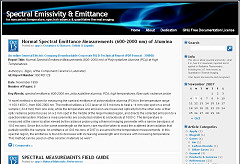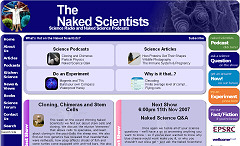 1. Emissivity Resource
1. Emissivity ResourceRay Peacock has created yet another excellent temperature measurement resource. The Spectral Emissivity & Emittance site collects relevant reports, field guides, and other free emissivity-related materials together in one place. If you need information on spectral emissivity, then head here. The site is designed so that users can post comments and suggest other useful sites or materials. Take a look and join in the conversation.
 2. Science Podcast
2. Science Podcast
If you're interested in science and have some time to kill, check out the Naked Scientists, a group of physicians and researchers from Cambridge University in the UK who want people to be as excited about science as they are. The name comes from their practice of stripping science down to the essentials to make it easier to understand. The podcasts are great fun, talking about recent important research or scientific topics, but the site is also home to articles on how thunderstorms work, why woodpeckers don't get brain damage, and a host of other topics. There are science book reviews, a discussion forum, and the kitchen science section that describes science experiments you can do at home.
 3. Online Sickness Map
3. Online Sickness Map
What do you get when you couple Google maps with the ability to post your symptoms if you're not feeling well? Who Is Sick, that's what. Here's how it works. If you're down with a cold or a stomach bug or what-have-you, you can go to the site and submit your location and symptoms. The result is the ability to look at a map of your area and see if there's a cluster of similar symptoms which may tell you if a flu bug or other virus is making its way through your neighborhood. While this doesn't replace a visit to your doctor, it's another tool to keep you notified of local outbreaks.
New to Bookshelves
 The LabVIEW Style Book
The LabVIEW Style Book
Author: Peter A. Blume
Publisher: Prentice Hall, Pearson Education Inc.
ISBN: 0-13-145835-3
Page count: 372
If you use LabVIEW a lot, and if you want to understand how to make your LabVIEW programming usable and able to be maintained by others, then you need to devote some time and effort to how you write it. This hardcover book is intended as a comprehensive reference for LabVIEW developers, covering style rules, programming tips, and techniques all collected into one place.
There are ten chapters and two appendices. These are: The Significance of Style, Prepare for Good Style, Front Panel Style, Block Diagram, Icon and Connector, Data Structures, Error Handling, Design Patterns, Documentation, and Code Reviews. The appendices include a glossary and a style rules summary.
The intended audience is the developers, managers, and organizations who use LabVIEW applications. The text is clear and there are many screenshots and other diagrams to illustrate the points discussed. The author has listed various rules, which are scattered throughout the text. These concise snippets of wise advice are collected in the Style Rules Summary in Appendix B. Each rule is introduced in context so that you understand why it exists and how to apply it.